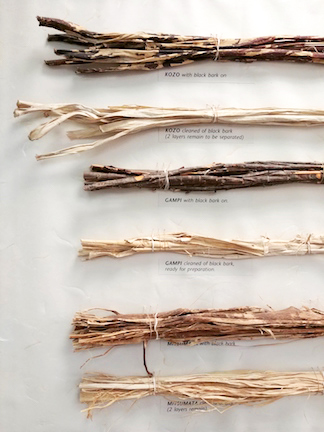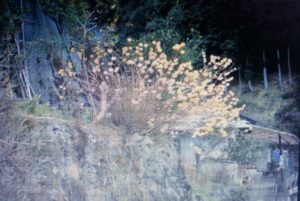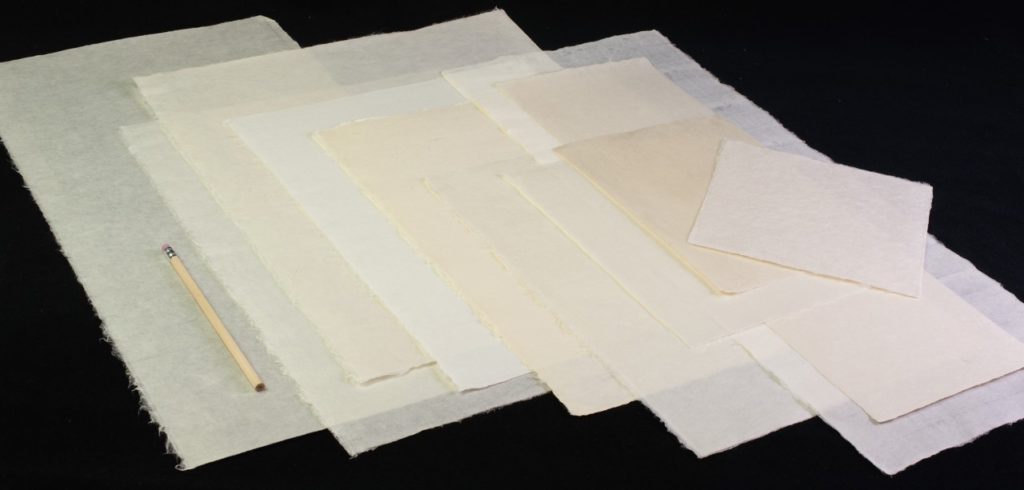Please note: This article was written by Paula Huisman of the Japanese Paper Place in Toronto, Canada. It was posted to our blog in 2019 by Sarah Edmonds.
What kind of washi should I use for my etching, dry point, lithograph, linocut, woodcut, collograph, silkscreen or monoprint?
It may seem like a tough call when there are hundreds of variations of Japanese papers, from heritage washi to the inexpensive, pulp-added, machine-made papers that exist. When used for any artwork, Japanese paper, especially washi, is transformed from mere surface to an integral part of the art in a way that seldom happens with western paper. Japanese paper, whether hand or machine-made are quite versatile, have a warmth and, if the word can be applied to paper, an “honesty” that is very difficult to describe, but instantly recognisable to the touch. Choosing handmade washi will give your prints the partnering they deserve.
Knowing what your paper is made of is a good first step to making our choice. Japanese paper is made using the inner bark of one of three renewable plants, two of which are cultivated and one of which only grows wild. The fibres of each plant lend distinct characteristics to the paper.
Kozo, is a species of mulberry indigenous to Japan. Although kozo can be sourced from Thailand, and China, kozo grown in Japan produces the finest result. The climate and careful hand-teding and harvesting of the crops that are a part of Japanese kozo production cannot be matched elsewhere. Kozo fibre is long and tough. The papers made with it are highly absorbent, translucent and strong even when very thin. Its great strength, even when wet, makes it an easy go-to for all kinds of printmaking whether you need washi for a bold relief or a delicate chine colle.

Gampi, is becoming the most precious of all Japanese paper-making fibres. Of the three, it is only one that cannot be cultivated. It grows wild only on the mountain sides and must be harvested completely by hand. Finding labourers willing to undertake this arduous task is increasingly difficult. Climate change also threatens the continued growth of gampi. Paper made from gampi is sought after for its incredible smoothness and delicate sheen. It has naturally-occuring sizing and holds even the finest detail which is why it was a favourite of Rembrandt for etching, and of many relief artists for the depth of colour it allows.
Mitsumata, is an indigenous Japanese shrub which takes three to five years before it is ready for harvest. Historically, mitsumata paper was used for banknotes because of its durability. Misumata has a naturally-occuring warm tone, and a very supple feel that belies its toughness. The tone lends itself surprisingly well to work in colour. Its absorbency makes mitsumata a wonderful choice for monoprint and lithography, but workable for any printmaking technique.

You are now armed with knowledge about the main types of washi, but there are still hundreds of papers to choose from. Looking at the key qualities of the paper will inform our choice depending on the printmaking techniques you are using. Considering the tone, translucency, absorbency, surface, the presence of inclusion, and whether the paper has been size (not a common practice with Japanese papermakers) is paramount to the result. For best results and longevity of your work, select papers with the highest percentage of kozo, gampi or mitsumata. Following are some of our suggestions, available in specialty art-supply stores around the world.
Inexpensive, very even, machine-made Kozuke is a kozo/sulphite blend and a great introductory paper for someone who is new to using Japanese paper. The inclusion of pulp gives Kozuke a familiar more “western” paper feel. Kozuke comes in sheet and roll formats at both 44g and 65g in white and ivory.
Kizuki Kozo, is a popular handmade pure Thai kozo paper that is of good quality. It is relatively heavy at 43g and useful for relief prints where clarity of line is more desired than heavy absorption. Both Kozuke and Kizuki Kozo are sized papers, making them particularly good for mokuhanga.
Usu Kuchi, a machine-made paper with Thai kozo, is unsized and available in three weights from “Light” at 21g to “Extra Heavy” at 65g. It is one of our go-to, all-purpose papers that rarely disappoints for any print technique.
For detail work, Gampi Smooth is a machine-made gampi fibre paper. Made with Phlippine gampi, it is reasonably priced gampi paper with a lovely crispness that lends itself well to printmaking.
If you are taken by the warm tone and suppleness of Mitsumata, you may want to try Inshu Mitsumata 20g – a particularly lovely choice for chine colle – or handmade mitsumata tissue that is available in 11g “light” and 22g “heavy” options.
If you feel ready for the best handmade paper, there are many more choices of size and colour. Before you start your next project, consider the options of translucency, colour, presence of inclusion, and don’t forget the beautiful small format washi. A few examples of the finest washi are Inshu gampi, sekishu (when made with 100% Japanese kozo), Oguni kozo, seichosen, and seikosen (made with kozo and mitsumata, respectively) and hosokawa.

Each style of printmaking has its specific needs. There is a Japanese paper that is optimum for your project. Now that you know the characteristics of the fibres used in Japanese paper and how they affect the finished project, you are well equipped to decide – or at least ask knowledgeable questions of a consultant at your favourite art supply store, or when you call paper specialists, like us, at The Japanese Paper Place.

Thanks, it’s really great to learn more about the different paper types. I’ll be entering the JPP comp as have been trying out different techniques on HoSho and Shoji Gami Kozo paper and I’ve fallen in love with the transparency and crisp print I get from Kozo. Good to understand more about the heritage of our printmaking tools and materials.
Fantastic read!